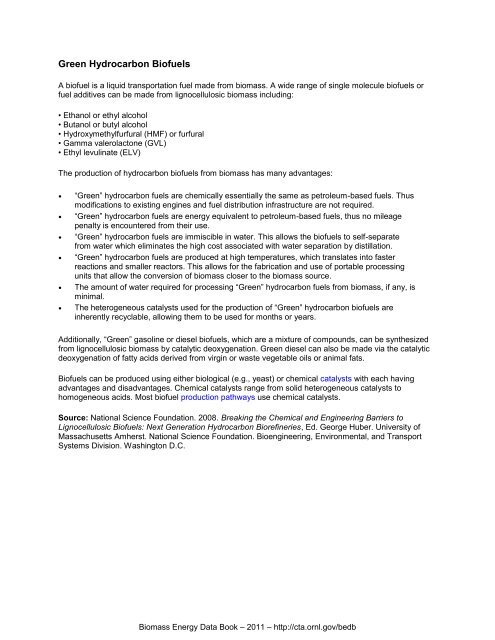Biomass Energy Data Book: Edition 4 - Full Document - Center for ...
Biomass Energy Data Book: Edition 4 - Full Document - Center for ...
Biomass Energy Data Book: Edition 4 - Full Document - Center for ...
Create successful ePaper yourself
Turn your PDF publications into a flip-book with our unique Google optimized e-Paper software.
Green Hydrocarbon Biofuels<br />
A biofuel is a liquid transportation fuel made from biomass. A wide range of single molecule biofuels or<br />
fuel additives can be made from lignocellulosic biomass including:<br />
• Ethanol or ethyl alcohol<br />
• Butanol or butyl alcohol<br />
• Hydroxymethylfurfural (HMF) or furfural<br />
• Gamma valerolactone (GVL)<br />
• Ethyl levulinate (ELV)<br />
The production of hydrocarbon biofuels from biomass has many advantages:<br />
• “Green” hydrocarbon fuels are chemically essentially the same as petroleum-based fuels. Thus<br />
modifications to existing engines and fuel distribution infrastructure are not required.<br />
• “Green” hydrocarbon fuels are energy equivalent to petroleum-based fuels, thus no mileage<br />
penalty is encountered from their use.<br />
• “Green” hydrocarbon fuels are immiscible in water. This allows the biofuels to self-separate<br />
from water which eliminates the high cost associated with water separation by distillation.<br />
• “Green” hydrocarbon fuels are produced at high temperatures, which translates into faster<br />
reactions and smaller reactors. This allows <strong>for</strong> the fabrication and use of portable processing<br />
units that allow the conversion of biomass closer to the biomass source.<br />
• The amount of water required <strong>for</strong> processing “Green” hydrocarbon fuels from biomass, if any, is<br />
minimal.<br />
• The heterogeneous catalysts used <strong>for</strong> the production of “Green” hydrocarbon biofuels are<br />
inherently recyclable, allowing them to be used <strong>for</strong> months or years.<br />
Additionally, “Green” gasoline or diesel biofuels, which are a mixture of compounds, can be synthesized<br />
from lignocellulosic biomass by catalytic deoxygenation. Green diesel can also be made via the catalytic<br />
deoxygenation of fatty acids derived from virgin or waste vegetable oils or animal fats.<br />
Biofuels can be produced using either biological (e.g., yeast) or chemical catalysts with each having<br />
advantages and disadvantages. Chemical catalysts range from solid heterogeneous catalysts to<br />
homogeneous acids. Most biofuel production pathways use chemical catalysts.<br />
Source: National Science Foundation. 2008. Breaking the Chemical and Engineering Barriers to<br />
Lignocellulosic Biofuels: Next Generation Hydrocarbon Biorefineries, Ed. George Huber. University of<br />
Massachusetts Amherst. National Science Foundation. Bioengineering, Environmental, and Transport<br />
Systems Division. Washington D.C.<br />
<strong>Biomass</strong> <strong>Energy</strong> <strong>Data</strong> <strong>Book</strong> – 2011 – http://cta.ornl.gov/bedb
















